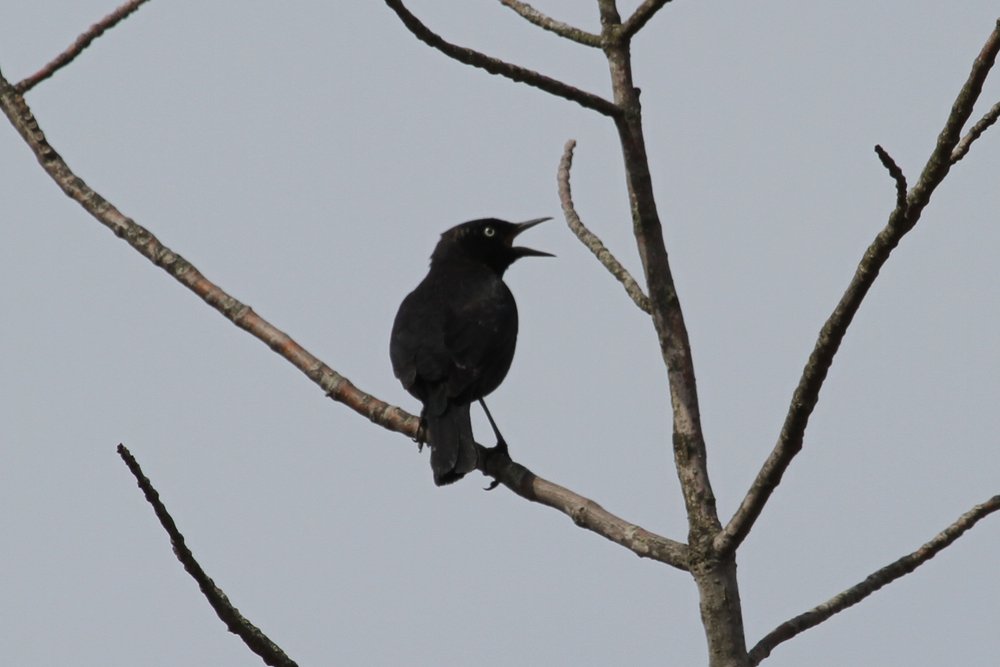
Yesterday I celebrated the first day of the Rusty Blackbird Blitz by walking out into the snowy Tivoli Bays to look for a Rusty. I knew full well I would not see one in the still frozen landscape of the bays. Even the Red-winged Blackbirds have not yet returned. Still, I had to go out on snowshoes to roll out the carpet for the Rusty should it decide to stop over later in the spring.

The first time I saw a Rusty Blackbird was three years ago on the muddy causeway of Cruger Island Road. It was the second spring of my bird-obsessed life, when every bird felt a miracle. My friend Peter introduced us: “Look now,” he said, “this is a bird that will be extinct in our lifetime.” What I saw was an ordinary enough bird, black overall, with a bit of brown rust at the nape, and then eyes, white as if they were bottomless. The bird had a grating song, like a squeaky hinge. At that time I doubted Peter’s pronouncement—it felt too full of doom—but research proved he might be right: Rusty populations have plummeted in the past century, with an 88% population reduction. Though scientists estimate that somewhere between 158,00 and 2 million remain, this once abundant bird is in a population free-fall.
158,000 to 2 million? Let’s put this into numbers people pay most attention to: who wants 2 million dollars? $158,000? But that’s as accurate as it gets because we know little about this bird. Part of it is that the Rusty breeds in inaccessible areas: boreal bogs. Tagging and re-finding those tagged birds has proven near impossible.
A 2010 article in The Condor is titled Rusty Blackbird: Mysteries of a Species in Decline. I can like a science article that admits to the mystery. Is it not all a mystery? That the birds are here at all? That I am here to watch them? that the planet continues to spin?
But the mystery that these scientists are mulling over is why the decline. There is no one simple answer. There’s habitat destruction—that’s almost a given with any dramatic species decline. The woods the Rusty needs on their wintering grounds in the southeastern United States have been transformed into agricultural land. The boreal wetlands where they breed have been lost to peat production, timber harvests, oil and gas exploration—the list is the usual nauseating one that makes me blur over. And then there’s mercury, which the Rusty encounters on both its breeding and wintering grounds. In acidic wetlands, mercury converts to its toxic form, methylmercury. This would likely kill the embryos of the Rusty.
Yet as important as understanding the bird’s breeding and wintering grounds is information on migration. Where do these birds rest up, gather fuel? This is what the Blitz, now in its second year, is about: scientists and conservationists want to understand the challenges this bird faces during migration. So during the next two months they want birders to focus on the Rusty by logging their sightings into eBird.
On my walk, it was quiet except for the crunch of snowshoes and the stop and start conversation with my friend Kate, who is game for any outing that involves snowshoes and birds. As we walked out Cruger Island, I pretended I really could see a Rusty even though there was not a bird in sight. And that possibility, this effort at tracking such an unassuming bird, made me insanely happy. So often it seems that the birds we want to save are the charismatic ones, the ones that are half myth, like the Whooping Crane. Don’t get me wrong, I love that the Whooper is being protected, but I worry that the less exciting birds are left behind. This Blitz gives me hope that we care for all of the birds. Thousands of birders will be out, logging the Rusty’s faint pathway north. Yesterday I did not add to the data, except to say that I tried.

As we left the causeway, a fluttering in some trees caught my attention. I turned my binoculars to see small birds bobbing from the end of branches, working dried seeds pods that looked like flat tin pennies. I tromped past the brush that lines the causeway and walked closer so I could see the little red caps, the white wing bars. Common Redpolls. I watched the birds gather an afternoon meal, wondering what their story might be, then continued on my way home.